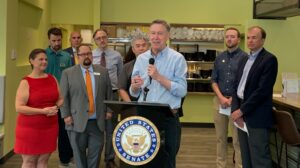Proposals Due September 22, 2022.
DENVER, CO –The U.S. Department of Agriculture (USDA) is investing up to $12 million in partnerships that expand access to conservation technical assistance for livestock producers and increase the use of conservation practices on grazing lands. USDA’s Natural Resources Conservation Service (NRCS) is accepting proposals through its Grazing Lands Conservation Initiative (GLCI) until September 22, 2022.
“Privately owned grazing lands cover nearly 30 percent of the national landscape, which means we have a tremendous opportunity to address climate change and conserve natural resources through voluntary, private lands conservation,” said Randy Randall, Acting NRCS State Conservationist for Colorado. “NRCS enlists a wide variety of conservation practices to help livestock producers. These partnerships will also help us expand the footprint of conservation on grazing lands and could help better reach historically underserved producers.”
Project proposals for GLCI Cooperative Agreements will identify and address barriers to accessing grazing assistance for producers. These partnerships are encouraged to include outreach and support for reaching historically underserved producers. Projects must address one or more of the following priorities:
- Address local natural resource concerns.
- Use climate-smart agriculture and forestry practices and principles.
- Encourage existing and new partnerships through emphasizing equity in advancing the resource needs of underserved communities.
- Identify and implement strategies to quantify, monitor, report on and verify conservation benefits associated with grazing management systems.
Through GLCI, NRCS will leverage the partnerships to increase availability of technical assistance for farmers and ranchers engaged in grazing activities and act as navigators for grazers seeking additional resources. The opportunity encourages knowledge and expertise in working with historically underserved producers, with a desired outcome of strong participation by historically underserved producers in new and existing grazing coalitions. GLCI intends to expand and establish new peer-to-peer networks for grazers and direct financial support for grazing mentors working with new, beginning, or transitioning grazers.
Eligibility for this opportunity is limited to the following entity types based in any of the 50 States, the District of Columbia, the Caribbean Area (Puerto Rico and the U.S. Virgin Islands), and the Pacific Islands Area (Guam, American Samoa, and the Commonwealth of the Northern Mariana Islands):
- Nonprofit organizations having a 501(c)(3) status with the Internal Revenue Service (IRS) (other than institutions of higher education)
- Farmer or rancher organizations
- State and local conservation governmental agencies
- Agricultural Extension Services
- Native American tribal governments (Federally recognized)
- Native American tribal organizations (other than Federally recognized tribal governments)
- Land grant universities including 1890 or 1994 land grant institution (7 U.S.C. 3222 et seq.), Hispanic-serving institution (20 U.S.C. 1101a), or other minority-serving institution, such as a historically Black college or university (20 U.S.C. 1061), a tribally controlled college or university (25 U.S.C. 1801), or Asian American and Pacific Islander-serving institution (20 U.S.C. 1059g)
For more information and to apply, visit the funding opportunity on grants.gov. Applications are being accepted now through September 22, 2022.












